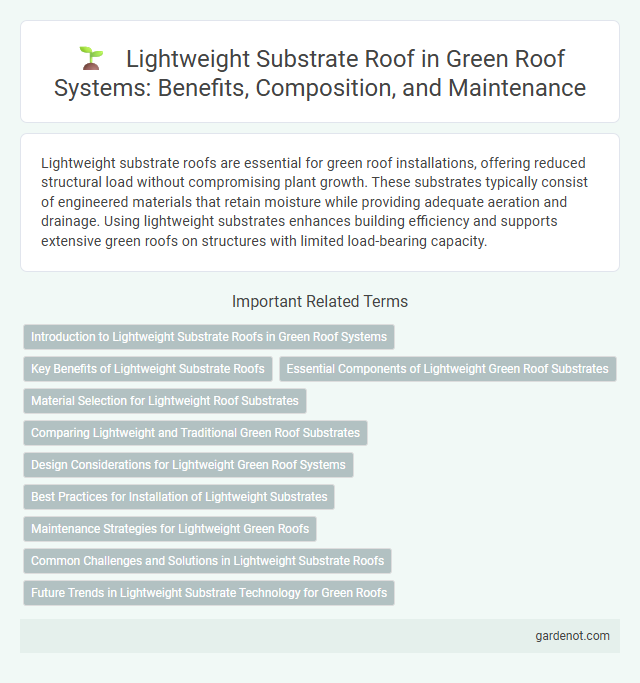Lightweight substrate roofs are essential for green roof installations, offering reduced structural load without compromising plant growth. These substrates typically consist of engineered materials that retain moisture while providing adequate aeration and drainage. Using lightweight substrates enhances building efficiency and supports extensive green roofs on structures with limited load-bearing capacity.
Introduction to Lightweight Substrate Roofs in Green Roof Systems
Lightweight substrate roofs in green roof systems utilize specially engineered growing media that reduce structural load while supporting robust plant growth, essential for urban environments with weight restrictions. These substrates typically consist of expanded clay, perlite, or pumice combined with organic matter to optimize water retention, aeration, and nutrient supply. Incorporating lightweight substrates enhances roof longevity and improves stormwater management by facilitating efficient drainage and minimizing soil compaction.
Key Benefits of Lightweight Substrate Roofs
Lightweight substrate roofs significantly reduce structural load, making them ideal for retrofitting existing buildings without extensive reinforcement. Enhanced thermal insulation properties of these substrates contribute to lower energy consumption and improved indoor comfort. Their excellent drainage capabilities prevent waterlogging, promoting healthy plant growth and extending roof lifespan.
Essential Components of Lightweight Green Roof Substrates
Lightweight green roof substrates typically consist of inorganic materials such as expanded clay, shale, or slate, combined with organic components like compost or peat to ensure proper drainage, aeration, and nutrient retention. Essential components include mineral aggregates for structural stability, organic matter to support plant growth, and moisture-retentive additives that balance water availability without oversaturation. These substrates must be engineered to maintain low weight while providing sufficient root support, water retention, and permeability to enhance the green roof's overall performance and longevity.
Material Selection for Lightweight Roof Substrates
Lightweight substrate roofs require materials that balance low density with high water retention and nutrient availability, commonly using expanded clay, perlite, or pumice as primary components. These substrates are engineered to optimize root growth and drainage while minimizing structural load, making them ideal for retrofit projects and buildings with limited load capacity. Selecting materials with a high porosity and stable pH enhances plant health and longevity, contributing to sustainable green roof performance.
Comparing Lightweight and Traditional Green Roof Substrates
Lightweight substrates for green roofs offer improved drainage and reduced structural load compared to traditional soil-based substrates, making them ideal for urban buildings with weight constraints. These substrates typically consist of expanded clay, pumice, or recycled materials that enhance root aeration and water retention while minimizing risk to roofing membranes. Traditional green roof substrates, often heavier and composed of natural soil, provide better nutrient availability but may require reinforced roof structures to support the additional weight.
Design Considerations for Lightweight Green Roof Systems
Lightweight substrate roofs require careful selection of materials that balance low density with sufficient structural support and moisture retention. Design considerations include evaluating load-bearing capacity, ensuring proper drainage layers to prevent water accumulation, and choosing substrates with high porosity to promote root aeration and plant health. Integration of lightweight insulation and waterproof membranes enhances thermal efficiency and durability in green roof systems.
Best Practices for Installation of Lightweight Substrates
Lightweight substrates for green roofs should be carefully selected to ensure optimal drainage, aeration, and nutrient retention while minimizing structural load on the building. Best practices for installation include thorough substrate testing, layering with adequate drainage mats, and evenly spreading a consistent depth to promote healthy plant growth and prevent compaction. Proper moisture management and regular substrate maintenance enhance the long-term durability and ecological performance of lightweight green roof systems.
Maintenance Strategies for Lightweight Green Roofs
Lightweight substrate roofs require tailored maintenance strategies to ensure optimal plant health and structural integrity. Regular inspections for substrate compaction, nutrient balance, and moisture levels are critical to prevent root damage and ensure proper drainage. Employing drought-tolerant plant species and scheduled irrigation reduces water stress, minimizing maintenance efforts while extending the roof's lifespan.
Common Challenges and Solutions in Lightweight Substrate Roofs
Lightweight substrate roofs often face challenges such as poor water retention, nutrient deficiency, and structural stability issues due to their reduced weight and thickness. Solutions include incorporating water-retentive materials like expanded clay or lava rock, using slow-release fertilizers to maintain nutrient levels, and reinforcing substrates with polymers or geotextiles to enhance durability and prevent substrate displacement. Regular monitoring and tailored maintenance programs ensure optimal plant health and substrate performance.
Future Trends in Lightweight Substrate Technology for Green Roofs
Advancements in lightweight substrate technology for green roofs emphasize enhanced water retention, improved nutrient delivery, and increased structural flexibility to support diverse vegetation types. Emerging materials such as biochar composites and recycled aggregate blends are gaining attention for their sustainability and performance benefits. Future trends indicate integration of smart sensors within substrates to monitor moisture levels and optimize plant health in real-time, driving the evolution of intelligent green roofing systems.
Lightweight substrate roof Infographic

 gardenot.com
gardenot.com